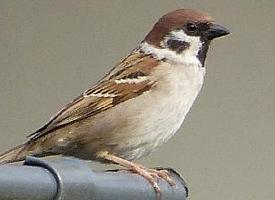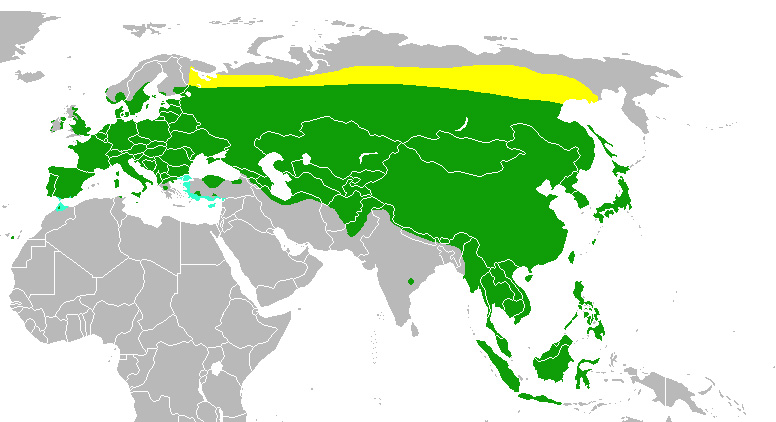
Poids et mesures
| Longueur | 14 cm |
|---|---|
| Poids | de 20 à 24 g |
| Envergure des ailes | 21 cm |
Description de l'animal
The Eurasian tree sparrow (Passer montanus) is a small, charming bird that is widespread across much of Eurasia. This species, closely related to the more familiar house sparrow, distinguishes itself through subtle differences in plumage and behavior, carving out its own unique niche in the avian world.Physically, the Eurasian tree sparrow is a compact bird, measuring around 12.5 to 14 cm in length, with a wingspan that ranges from 20 to 22 cm. It typically weighs between 18 to 25 grams, making it a lightweight avian species. One of its most distinguishing features is its rich chestnut crown and nape, contrasting sharply with the white cheeks adorned with a distinctive black cheek spot. The bird's upper parts are predominantly a warm, earthy brown, streaked with black, while the underparts are a lighter, dull white or grey. The sexes are similar in appearance, which is somewhat unusual in the bird world, where males often boast more vibrant plumage.
The Eurasian tree sparrow's habitat is quite varied, ranging from open woodlands and farmlands to urban areas, where it often lives in close proximity to humans. Unlike its cousin, the house sparrow, the Eurasian tree sparrow prefers nesting in trees, hence its name. It is a highly sociable bird, often seen in small flocks, especially outside of the breeding season.
When it comes to diet, this species is omnivorous, feeding on a mix of seeds, fruits, and insects. Its diet varies seasonally; during the warmer months, insects constitute a larger portion of its diet, providing essential protein for the growth and development of its young. In the colder months, seeds and grains become the primary food source, helping to sustain the bird through winter.
Breeding season for the Eurasian tree sparrow begins in early spring and can last until late summer, depending on the climate of their habitat. They are monogamous birds, with pairs often forming strong bonds. Nests are typically built in the cavities of trees or sometimes in buildings or bird boxes, where the female lays a clutch of 4 to 6 eggs. Both parents share in the duties of incubating the eggs and feeding the young, showcasing a cooperative breeding behavior that ensures the survival and growth of their offspring.
Despite facing threats from habitat destruction and pollution, the Eurasian tree sparrow has proven to be adaptable, maintaining stable populations in many parts of its range. Its presence is often welcomed by birdwatchers and nature enthusiasts, who admire not only its beauty but also its resilience and the joy it brings to everyday life.
In summary, the Eurasian tree sparrow is a small yet fascinating bird, characterized by its distinctive appearance, versatile diet, and sociable behavior. As a species that has adeptly navigated the challenges of both natural and urban environments, it stands as a testament to the adaptability and resilience of the natural world.
Carte de répartition

Animaux similaires
Nouvelles photos d'animaux
Top 10 des animaux
- Dolphin gull (Leucophaeus scoresbii)
- Japanese macaque (Macaca fuscata)
- Stone loach (Barbatula barbatula)
- Greek tortoise (Testudo graeca)
- Russian tortoise (Testudo horsfieldii)
- Galápagos tortoise (Geochelone nigra complex)
- Diana monkey (Cercopithecus diana)
- Moustached guenon (Cercopithecus cephus)
- Common flying dragon (Draco volans)
- Galápagos penguin (Spheniscus mendiculus)

